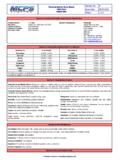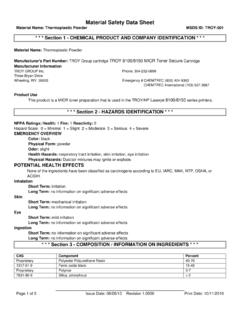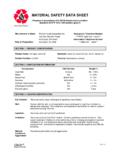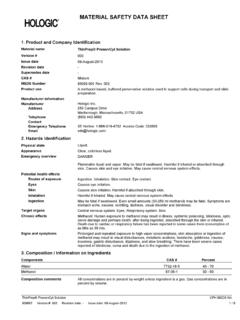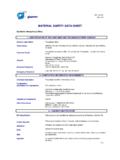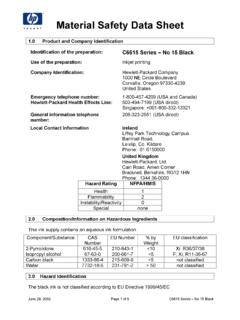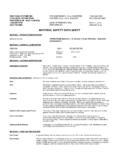Transcription of Material Safety Data Sheet: Revision No.: B …
1 Revision No.: B. Material Safety data sheet : Aluminium Alloy Issue Date: 05/07/2010. msds -001. Pages: 1 of 4. Section 1: Product Information and Company Identification Product Name: Aluminium Alloy Contact Information: MCPS Ltd Synonym: Al/In/Zn 102/2A Throckley Way Chemical Name: None Allocated Middlefields Industrial Estate Chemical Formula: None Allocated South Shields Hazchem Code: None Allocated Tyne & Wear NE34 0NU. England Tel: +44 (0) 191 456 0466. Fax: +44 (0) 191 454 1066. Web: Email: Section 2: Composition and Information on Elements Aluminium MIL-DTL- Alloy A-Guard G3 DNV-RP-B401 ISO 15589-2 NORSOK M-503. 24779A(SH). Elements %. Zinc - - - - - - Indium - - - - - - Silicon - - - max. max. max. Iron max. max. max. max. max. max. Copper max. max. max. max. max. max. Mercury - - max. - - - Tin - - max. - - - Cadmium - - - max. max. - Others max. max. (ea.) max. - max. (ea.) max. (ea.). Aluminium Remainder Remainder Remainder Remainder Remainder Remainder Section 3: Hazards Identification Potential Acute Health Effects: Slightly hazardous in case of skin contact (irritant).
2 Non-irritating to the eyes. Non-hazardous in case of ingestion. Potential Chronic Health Effects: CARCINOGENIC EFFECTS: Not available. MUTAGENIC EFFECTS: Not available. TERATOGENIC EFFECTS: Not available. DEVELOPMENTAL TOXICITY: Not available. The substance is toxic to lungs. Repeated or prolonged exposure to the substance can produce target organs damage. Repeated exposure to a highly toxic Material may produce general deterioration of health by an accumulation in one or many human organs. Section 4: First Aid Measures Eye Contact: Check for and remove any contact lenses. In case of contact, immediately flush eyes with plenty of water for at least 15 minutes. Get medical attention if irritation occurs. Skin Contact: Wash with soap and water. Cover the irritated skin with an emollient. Get medical attention if irritation develops. Serious Skin Contact: Not available. Inhalation: If inhaled, remove to fresh air. If not breathing, give artificial respiration.
3 If breathing is difficult, give oxygen. Get medical attention immediately. Serious Inhalation: Not available. Ingestion: Do NOT induce vomiting unless directed to do so by medical personnel. Never give anything by mouth to an unconscious person. If large quantities of this Material are swallowed, call a physician immediately. Loosen tight clothing such as a collar, tie, belt or waistband. Serious Ingestion: Not available. Marine Cathodic Protection Systems Ltd Revision No.: B. Material Safety data sheet : Aluminium Alloy Issue Date: 05/07/2010. msds -001. Pages: 2 of 4. Section 5: Fire and Explosion data Flammability of the Product: Non-flammable. Auto-Ignition Temperature: Not available. Flash Points: Not available. Flammable Limits: Not available. Products of Combustion: Some metallic oxides. Fire Hazards in Presence of Various Substances: Not available. Explosion Hazards in Presence of Various Substances: Risks of explosion of the product in presence of mechanical impact: Not available.
4 Risks of explosion of the product in presence of static discharge: Not available. Fire Fighting Media and Instructions: SMALL FIRE: Use DRY chemical powder. LARGE FIRE: Use water spray, fog or foam. Do not use water jet. Special Remarks on Fire Hazards: Not available. Special Remarks on Explosion Hazards: Not available. Section 6: Accidental Release Measures Small Spill: Use appropriate tools to put the spilled solid in a convenient waste disposal container. Finish cleaning by spreading water on the contaminated surface and dispose of according to local and regional authority requirements. Large Spill: Use a shovel to put the Material into a convenient waste disposal container. Finish cleaning by spreading water on the contaminated surface and allow evacuating through the sanitary system. Section 7: Handling and Storage Precautions: Do not ingest. Wear suitable protective clothing. If ingested, seek medical advice immediately and show the container or the label.
5 Keep away from incompatibles such as oxidizing agents, acids, alkalis. Storage: Keep container tightly closed. Keep container in a cool, well-ventilated area. Moisture sensitive. Section 8: Exposure Controls / Personal Protection Engineering Controls: Use process enclosures, local exhaust ventilation, or other engineering controls to keep airborne levels below recommended exposure limits. If user operations generate dust, fume or mist, use ventilation to keep exposure to airborne contaminants below the exposure limit. Personal Protection: Safety glasses. Lab coat. Gloves. Personal Protection in Case of a Large Spill: Safety glasses. Lab coat. Gloves. Exposure Limits: Consult local authorities for acceptable exposure limits. Section 9: Physical and Chemical Properties Physical state and appearance: Solid. Specific Gravity: Density: (Water = 1). Odour: Odourless. Vapour Pressure: Not applicable. Taste: Not available. Vapour Density: Not available. Molecular Weight: 2700 - 2750 kg/m3 Volatility: Not available.
6 Colour: Silver-white Odour Threshold: Not available. pH (1% soln/water): Not applicable. Water/Oil Dist. Coeff.: Not available. Boiling Point: 2327 C ( F) Ionicity (in Water): Not available. Melting Point: 660 C (1220 F) Dispersion Properties: Not available. Critical Temperature: Not available. Solubility: Insoluble in cold water, hot water. Soluble in alkalies, Sulphuric acid, Hydrochloric acid. Insoluble in concentrated Nitric Acid, hot Acetic acid. Marine Cathodic Protection Systems Ltd Revision No.: B. Material Safety data sheet : Aluminium Alloy Issue Date: 05/07/2010. msds -001. Pages: 3 of 4. Section 10: Stability and Reactivity data Stability: The product is stable. Instability Temperature: Not available. Conditions of Instability: Incompatible materials, exposure to moist air or water. Incompatibility with various substances: Reactive with oxidizing agents, acids, alkalis. Corrosivity: Not available. Special Remarks on Reactivity: Moisture sensitive.
7 Aluminium reacts vigorously with Sodium Hydroxide. Aluminium is also incompatible with strong oxidizers, acids, chromic anhydride, iodine, carbon disulfide, methyl chloride, and halogenated hydrocarbons, acid chlorides, ammonium nitrate, ammonium persulfate, antimony, arsenic oxides, barium bromate, barium chlorate, barium iodate, metal salts. Special Remarks on Corrosivity: In moist air, oxide film forms which protects metal from corrosion. Aluminium is strongly electropositive so that it corrodes rapidly in contact with other metals. Polymerization: Will not occur. Section 11: Toxicological Information Routes of Entry: Not available. Toxicity to Animals: Not available Chronic Effects on Humans: Not available. Other Toxic Effects on Humans: Slightly hazardous in case of skin contact (irritant). Non-hazardous in case of ingestion. Non-hazardous in case of inhalation. Special Remarks on Toxicity to Animals: Not available. Special Remarks on Chronic Effects on Humans: Not available.
8 Special Remarks on other Toxic Effects on Humans: Acute Potential Health Effects: Skin: Exposure to Aluminium may cause skin irritation. Eyes: Not expected to be a hazard unless Aluminium dust particles are present. Exposure to Aluminium dust may cause eye irritation by mechanical action. Aluminium particles deposited in the eye are generally innocuous. Inhalation: Not expected to be an inhalation hazard unless it is heated or if Aluminium dust is present It heated or in dust form, it may cause respiratory tract irritation. Heating Aluminium can release Aluminium Oxide fumes and cause fume metal fever when inhaled. This is a flu-like illness with symptoms of metallic taste, fever, chills, aches, chest tightness, and cough. Ingestion: Acute Aluminium toxicity is unlikely. Chronic Potential Health Effects: Skin: Contact dermatitis occurs rarely after Aluminium exposure. Most cases of Aluminium toxicity in humans are in one of two categories: patients with chronic renal failure, or people exposed to Aluminium fumes or dust in the workplace.
9 The main source of Aluminium in people with chronic renal failure was in the high Aluminium content of the water for the dialysate used for dialysis in the 1970's in America. Even though this problem was recognized and corrected, Aluminium toxicity continues to occur in some individuals with renal who chronically ingest Aluminium-containing phosphate binders or antacids. Inhalation: Chronic exposure to Aluminium dust may cause dyspnoea, cough, asthma, chronic obstructive lung disease, pulmonary fibrosis, pneumothorax, pneumoconiosis, encephalopathy, weakness, in-coordination and epileptiform seizures and other neurological symptoms similar to that described for chronic ingestion. Hepatic necrosis is also a reported effect of exposure to airborne particulates carrying Aluminium. Ingestion: Chronic ingestion of Aluminium may cause Aluminium Related Bone Disease or Aluminium-induced Osteomalacia with fracturing Osteodystrophy, microcytic anemia, weakness, fatigue, visual and auditory hallucinations, memory loss, speech and language impairment (dysarthria, stuttering, stammering, anomia, hypofluency, aphasia and eventually, mutism), epileptic seizures(focal or grand mal), motor disturbance (tremors, myoclonic jerks, ataxia, convulsions, asterixis, motor apraxia, muscle fatigue), and dementia (personality changes, altered mood, depression, diminished alertness, lethargy, 'clouding of the sensorium', intellectual deterioration, obtundation, coma), and altered EEG.
10 Section 12: Ecological Information Ecotoxicity: Not available. BOD5 and COD: Not available. Products of Biodegradation: Possibly hazardous short term degradation products are not likely. However, long term degradation products may arise. Toxicity of the Products of Biodegradation: The products of degradation are less toxic than the product itself. Special Remarks on the Products of Biodegradation: Not available. Marine Cathodic Protection Systems Ltd Revision No.: B. Material Safety data sheet : Aluminium Alloy Issue Date: 05/07/2010. msds -001. Pages: 4 of 4. Section 13: Disposal Considerations Waste Disposal: Waste must be disposed of in accordance with federal, state and local environmental control regulations. Section 14: Transport Information Transport: Aluminium is considered stable under normal handling conditions. Keep Aluminium metal clean and dry during transport. DISCLAIMER. The information above is believed to be accurate and represents the best information currently available to MCPS Ltd.
